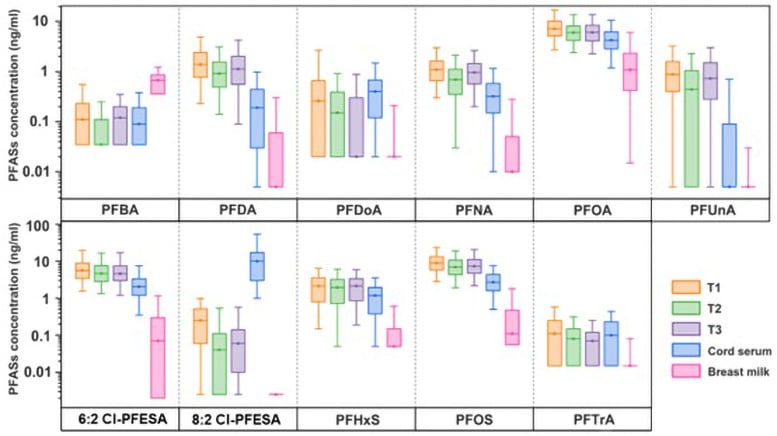 精选
精选
令人吃惊的研究表明,永久有毒化学物质可以穿透人体皮肤
诸平
之前曾经介绍过永久化学品:美中研究人员开发出能够毁坏“永久化学品”的反应器、永久化学品的危机:全球水资源超过安全的PFAS限制、研究人员改进了用阳光摧毁“永久化学物质”的催化剂、某些全氟烷基和多氟烷基“永久化学品”被确定为甲状腺潜在危险因素、欧美PFAS污染研究二三事、乌得勒支科学园投入245万美元用于解决 PFAS问题的研究等,网络上的相关报道也很多(卫生纸中检出有害“永久性化学品”、新方法清除“永久化学品”廉价又方便、PFAS ——有害的“永久性化学品” 等 )。今天来介绍英国伯明翰大学(University of Birmingham)以及我国复旦大学各自的最新研究结果。
据英国伯明翰大学(University of Birmingham, Birmingham B15 2TT, UK)2024年7月6日提供的消息,令人吃惊的研究表明,永久有毒化学物质可以穿透人体皮肤(Startling Research Shows That Toxic “Forever Chemicals” Can Penetrate Human Skin)
最近的一项研究表明,许多消费品中使用的有毒化学物质全氟烷基物质(perfluoroalkyl substances简称PFAS)可以通过皮肤吸收到血液中,这挑战了之前的假设,并强调了对这些永久性化学物质(‘forever chemicals’)进行进一步研究的必要性,强调需要进一步研究这些广泛使用的物质对健康的影响。
对17种广泛使用的合成永久化学物质的研究表明,这些有害物质很容易通过人体皮肤吸收。发表在《国际环境》(Environment International)杂志上的一项新研究首次证明,多种在自然界中不会分解的PFAS化学物质可以穿透皮肤屏障,进入人体血液。原文详见:Oddný Ragnarsdóttir, Mohamed Abou-Elwafa Abdallah, Stuart Harrad. Dermal bioavailability of perfluoroalkyl substances using in vitro 3D human skin equivalent models. Environment International, 2024, 188, Article number: 108772. DOI: 10.1016/j.envint.2024.108772. Epub 23 May 2024.
从校服到个人护理产品,各种与人体皮肤接触的产品中均发现了全氟烷基物质 (PFAS)。尽管如此,关于人类皮肤吸收 PFAS 的知识仍然缺乏。因此,首次使用3D人体皮肤等效模型暴露于溶解在甲醇中的 500 ng/cm2 PFAS 24~36 小时,评估了人体皮肤对17种PFAS的吸收。目标PFAS的分布基于3个部分:吸收、未吸收和保留在皮肤组织内(可吸收剂量)。全氟戊酸 (Perfluoropentanoic acid简称PFPeA) 和全氟丁磺酸盐(perfluorobutane sulfonate简称PFBS) 的吸收分数最高,分别为58.9%和48.7%,吸收分数随着所研究的全氟羧酸(perfluorocarboxylic acids简称PFCA) (r = 0.97,p = 0.001)和全氟磺酸(perfluorosulfonic acids简称PFSA)(r = 0.97,p = 0.004)碳链长度的增加而降低。有趣的是,虽然长链 PFAS (Cn≥9) 没有被直接吸收,但在暴露结束时,在皮肤组织内检测到了很大一部分暴露剂量。这对于全氟十一烷酸(perfluoroundecanoic acid简称PFUnDA)和全氟壬烷磺酸盐 (perfluorononane sulfonate简称PFNS)最为明显,在皮肤组织内发现了66.5%和68.3%的暴露剂量,而在吸收部分中没有检测到这两种化合物。对于碳链长度>11的化合物,在皮肤组织中发现的分数随着链长度的增加而减少。理化性质对PFAS的真皮渗透有影响,PFCAs (r = -0.97;p ≤ 0.001) 和 PFSAs (r = -0.99;p ≤ 0.001) 的logKOW和吸收分数之间存在明显的负相关。对暴露36小时后具有显著渗透的目标化合物(C5-C8 PFCAs和C4-C7 PFSAs)的稳态通量{Steady-state flux (JSS)} 和渗透系数{ permeation coefficients (Papp)} 测定。一般来说,通量和渗透系数都随着链长的增加而降低。
由于PFAS具有防水和防污的特性,它被广泛应用于工业和消费品中,从校服到个人护理产品。虽然一些物质已被政府法规禁止,但其他物质仍被广泛使用,其毒性影响尚未得到充分研究。已知PFAS可通过其他途径进入人体,例如通过呼吸或通过食物或饮用水摄入,并且已知它们会对健康造成不利影响,例如对疫苗接种的免疫反应降低、肝功能受损和出生体重下降。
人们普遍认为,PFAS不能突破皮肤屏障,尽管最近的研究表明,个人护理产品的使用与人体血液和母乳中PFAS浓度之间存在联系。这项新研究是迄今为止对PFAS进入人体皮肤的吸收进行的最全面的评估,并证实大多数PFAS可以通过这一途径进入人体。
研究详情(Details of the Research)
上述研究论文的主要作者Oddný Ragnarsdóttir博士在伯明翰大学攻读博士学位时进行了这项研究。她解释说:“这些化学物质通过皮肤被吸收的能力此前一直被忽视,因为这些分子被电离了。人们认为,使它们具有拒水和抗污渍能力的电荷也使它们无法穿过皮肤膜。我们的研究表明,这一理论并非总是正确的,事实上,通过皮肤吸收可能是接触这些有害化学物质的一个重要来源。”
研究人员考查了17种不同的PFAS物质。所选择的化合物是那些使用最广泛的化合物,它们的毒性作用和人类可能接触到它们的其他途径也得到了最广泛的研究。最重要的是,它们符合欧盟饮用水指令(EU’s Drinking Water Directive)规定的化学物质。
在他们的实验中,研究小组使用了3D人体皮肤等效模型,多层实验室培养的组织模仿了正常人类皮肤的特性,这意味着这项研究可以在不使用任何动物的情况下进行。他们使用每种化学物质的样品来测量模型中被吸收、未吸收或保留的比例。
实验结果及启示(Experiment Findings and Implications)
在测试的17种PFAS中,研究小组发现15种物质的皮肤吸收至少达到暴露剂量的5%。在考查的暴露剂量下,最受监管的PFAS类化合物——全氟辛酸{perfluoro octanoic acid (PFOA)}进入血液的吸收量为13.5%,另外38%的施用剂量保留在皮肤内,可能长期进入循环。
吸收的量与分子内碳链的长度有关。碳链较长的物质吸收水平较低,而链较短的化合物被引入以取代碳链较长的PFAS,如PFOA,更容易被吸收。例如,全氟戊酸(perfluoro pentanoic acid)的吸收率是全氟辛酸(PFOA)的四倍,为59%。
该研究的合著者穆罕默德·阿卜杜拉博士(Dr Mohamed Abdallah)说:“我们的研究首次揭示了皮肤途径作为接触各种永久性化学物质的途径的重要性。鉴于现有的PFAS数量众多,重要的是,未来的研究旨在评估这些有毒化学物质的广泛范围的风险,而不是一次只关注一种化学物质。”
该研究的合著者、伯明翰大学地理、地球和环境科学学院(University of Birmingham’s School of Geography, Earth and Environmental Sciences)的斯图尔特·哈拉德教授(Professor Stuart Harrad)补充说:“这项研究帮助我们了解通过皮肤接触这些化学物质的重要性,以及哪些化学结构最容易被吸收。这很重要,因为我们看到工业转向使用链长度较短的化学品,因为这些化学品被认为毒性较小,但代价可能会使我们吸收更多的永久性化学品,所以我们需要更多地了解所涉及的风险。”
上述介绍,仅供参考。欲了解更多信息,敬请注意浏览原文或者相关报道。
Perfluoroalkyl substances (PFAS) have been identified in various products that come in contact with human skin, ranging from school uniforms to personal care products. Despite this, knowledge on human dermal uptake of PFAS is lacking. Thus, the human dermal absorption of 17 PFAS was assessed, for the first time, using in vitro 3D-human skin equivalent models exposed to 500 ng/cm2 PFAS dissolved in methanol over 24-36 h. The distribution of target PFAS is presented, based on three fractions: absorbed, un-absorbed, and retained within skin tissue (absorbable dose). Perfluoropentanoic acid (PFPeA) and perfluorobutane sulfonate (PFBS) had the highest absorbed fraction, 58.9 % and 48.7 % respectively, with the absorbed fraction decreasing with increasing carbon chain length of the studied perfluorocarboxylic acids (PFCAs) (r = 0.97, p = 0.001) and perfluorosulfonic acids (PFSAs) (r = 0.97, p = 0.004). Interestingly, while longer chain PFAS (Cn ≥ 9) were not directly absorbed, a large fraction of the exposure dose was detected within the skin tissue at the end of the exposure. This was most apparent for perfluoroundecanoic acid (PFUnDA) and perfluorononane sulfonate (PFNS) for which 66.5 % and 68.3 % of the exposure dose was found within the skin tissue, while neither compound was detected in the absorbed fraction. For compounds with a carbon chain length > 11, the fraction found within the skin tissue, decreases with increasing chain length. Physicochemical properties played a role in dermal permeation of PFAS, with a clear inverse correlation between logKOW and absorbed fraction for both PFCAs (r = -0.97; p ≤ 0.001) and PFSAs (r = -0.99; p ≤ 0.001). Steady-state flux (JSS) and permeation coefficients (Papp) were determined for target compounds with significant permeation after 36 h exposure (C5-C8 PFCAs and C4-C7 PFSAs). In general, both the flux and permeation coefficient decreased with increasing chain length.
《科技日报》(SciTechDaily)网站2024年7月7日报道了来自南京环境科学研究所(Nanjing Institute of Environmental Sciences)消息,介绍复旦大学的最新研究:“令人震惊的研究揭示了化学物质如何永远从母亲转移到新生儿”(Alarming Study Unveils How “Forever Chemicals” Transfer From Mothers to Newborns)原文如下:
Alarming Study Unveils How “Forever Chemicals” Transfer From Mothers to Newborns
TOPICS: Breast Milk Environment Public Health Toxicology
By Nanjing Institute of Environmental Sciences July 7, 2024
A recent study on PFAS exposure in infants shows that these chemicals are more likely to cross the placenta than transfer through breastfeeding, underscoring the need for stricter regulations and better protective measures for infants.
A recent study by Fudan University found high levels of PFAS in maternal and infant sera and breast milk, indicating significant placental transfer and underscoring the need for stringent regulations to protect infants from exposure.
Researchers have made a crucial scientific breakthrough by investigating the key mechanisms and health effects of polyfluoroalkyl substances (PFAS) exposure in infants, examining how these chemicals are transmitted through the placenta and breast milk. This research represents a major advance in our comprehension of environmental pollutants and their effects on the most susceptible groups.
Polyfluoroalkyl substances (PFAS) are a class of chemicals extensively used in consumer goods production due to their hydrophobic and oleophobic properties and stability. However, their persistence in the environment and bioaccumulation in living organisms have sparked concerns about potential health effects. Previous studies have linked PFAS exposure to various adverse outcomes, including developmental issues in children.
Box-plots of concentrations of PFAS with > 50% detection in maternal serum across trimesters (T1-T3), cord serum or breast milk (ng/mL). The lower and upper edges of the box represent the first and third quartiles, respectively, while the line inside the box denotes the median level. The whiskers mark the 5th and 95th percentiles. Credit: Eco-Environment & Health
A recent study published in Eco-Environment & Health on May 8, 2024, has highlighted the levels, health risks, and transport protein binding capabilities of per- and polyfluoroalkyl substances (PFAS) in early life based on the Shanghai Maternal-Child Pairs Cohort. Found in maternal serum, cord serum, and breast milk, these synthetic chemicals pose potential health risks for infants. Led by a research team from the School of Public Health at Fudan University, the research team meticulously analyzed the transfer mechanisms and impacts of these persistent chemicals, providing crucial insights into their pervasive presence from pregnancy to lactation.
Methodology and Key Findings
Employing high-performance liquid chromatography-tandem mass spectrometry, the study analyzed 16 types of PFAS in 1,076 mother-child pairs. It revealed the detection rates and median concentrations of perfluorooctane sulfonate (PFOS), perfluorooctanoic acid (PFOA), and 6:2 Cl-PFESA, with PFOS most prevalent in maternal serum. Notably, the placental transfer efficiency of PFAS was higher than breastfeeding transfer, suggesting that these chemicals are more likely to cross the placenta and accumulate in the fetus. Additionally, the research utilized molecular docking to simulate the binding of PFAS to transport proteins, potentially influencing their distribution and transport within the body. These findings underscore the need for tighter PFAS regulations and further research into their environmental and health effects.
Ms. Yaqi Xu, lead author of the study, states, “Our findings are crucial for developing strategies to protect infants from the potentially harmful effects of PFAS exposure. Understanding the pathways and risks associated with these chemicals can lead to better regulatory policies and protective measures for the most susceptible among us.”
The implications of this research are profound, particularly for public health policies and infant safety. By identifying specific PFAS compounds more likely to transfer through the placenta and into breast milk, preventive measures can be more effectively targeted. Moreover, the study’s findings could influence future guidelines on the use of PFAS-containing products by pregnant women and nursing mothers.
Reference: “Early-life exposure to per- and polyfluoroalkyl substances: Analysis of levels, health risk and binding abilities to transport proteins” by Yaqi Xu, Xinyao Sui, Jinhong Li, Liyi Zhang, Pengpeng Wang, Yang Liu, Huijing Shi and Yunhui Zhang, 8 May 2024, Eco-Environment & Health. DOI: 10.1016/j.eehl.2024.04.007
This work was supported by the National Natural Science Foundation of China (Grant No. 82273585) and the National Key Research and Development Program of China (Grant No. 2022YFC2705004, 2019YFE0114500).
转载本文请联系原作者获取授权,同时请注明本文来自诸平科学网博客。
链接地址:https://wap.sciencenet.cn/blog-212210-1441412.html?mobile=1
收藏




